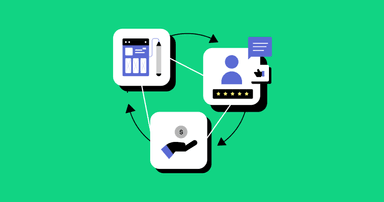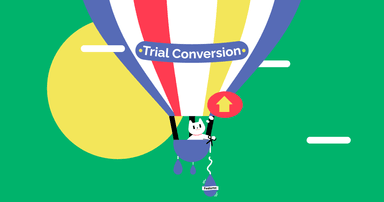TAM SAM SOM for apps: Everything subscription apps need to know
What are total addressable market, serviceable addressable market, and serviceable obtainable market and how should you use them?


Peter Meinertzhagen
Understanding the scope of your market is essential for your app’s long-term success.
It shapes everything from how you make money to the direction your product takes. This rings even truer for apps targeting a niche audience — understanding the limits of your market is key to your app’s strategy and vision.
In this blog post, we’re going to explore three important metrics, TAM SAM & SOM, that will help you understand your market:
- Total addressable market (TAM)
- Serviceable addressable marketing (SAM)
- Serviceable obtainable market (SOM)
Let’s start with some basic definitions.
Defining TAM, SAM, and SOM
Total addressable market (TAM): The total global market size. This is everyone who could potentially use your app. It’s the widest view of your market opportunity. This is the number you should always have at the back of your mind, but not the one you’ll base your modeling on.
Serviceable addressable market (SAM): The portion of your TAM that your app can actually serve. This narrows down to those within your reach, considering your app’s current business model and features.
Serviceable obtainable market (SOM): The portion of the SAM that you can realistically obtain, given the competitive landscape. How much of your SAM can you capture vs. your competitors?
The use cases for TAM
Understanding the size of your potential customer base is important, and TAM is the broadest view of this. There are two main use cases for using TAM:
- Pitching to investors — TAM can be used as a sales tactic for your app. When talking to investors, the total addressable market tells a story of how big the opportunity is. However, you need to be prepared to go deeper than this.
- Long-range modeling — While SAM, as we’ll see, is more directly useful for your strategy, your TAM illustrates your scope for growth. As your product and the market evolves, inevitably your SAM will grow and TAM gives you an idea of how much room it has.
However, while TAM is a fine starting point, it’s not enough to feed your immediate strategy. When Surfline’s Vice President of Strategy, Business Development, and Analytics Paul Ganev sat down with us on the Sub Club podcast, he highlighted the biggest mistake made by companies putting together their commercial strategy: they base their market size on their TAM.
We’ll share the example Paul gives when explaining this.
“The flaws come when you start trying to calculate the addressable audience from a modeling standpoint and what you should do strategically for product and monetization. So I’ll give you an example. Let’s say we’re a golf company and you go out to market and you say, okay, there’s 50 million golfers in the US. That’s our TAM.
If you’re launching a subscription product, you’ll probably find pretty quickly after you launch the product that there’s 50 million golfers out there, but there aren’t 50 million golfers who play golf on a frequent basis. Maybe it’s 20 million that actually play on a frequent basis. And so you’re kind of omitting a key factor, which is commitment.
You really have to move from TAM to another metric that’s used in the industry called the serviceable addressable market, SAM.”
What is SAM? Serviceable addressable market
With SAM, you’re looking at the % of your TAM that you can actually serve.
For an example on how you whittle your TAM down into SAM, let’s say you have a meditation app. There might be 38 million people in the US who meditate (already, we’ve narrowed our global TAM by geography). If your app is only available on iOS, there’s about 40% of the market that you cannot serve.
One of the reasons SAM is really important is that it defines what your commercial strategy should be. For example, if your SAM is small, you might reach market saturation more quickly. This means that your best strategic bet might be to focus on growing average revenue per user (ARPU) instead. Or, you might look to expand your audience by reaching other geographies or adjacent markets.
It puts us in mind of Steve P. Young’s 2024 prediction based on our SOSA report: “Niche apps are going to make a comeback. My theory and our approach to building apps is to build a portfolio of apps making $5-10K MTR instead of trying to build one app making $100K MTR.”
Under this model, you’re expanding your addressable market with adjacent apps as part of a wider portfolio.
So should you forget TAM altogether? No, definitely not. You should always have TAM in the back of your mind because as your business and product continues to evolve, your TAM and SAM, and the delta between them, will evolve too. And at the other end of the spectrum, right at the beginning of your journey, TAM is a useful indication of the potential going into your app idea. If the TAM for your app idea is small, that doesn’t invalidate your idea, but it does mean that your pricing will probably need to be higher as a result.
What is SOM? Serviceable obtainable market
Going a step deeper is your SOM: What segment of your SAM can you realistically convert?
Here, things get more complicated, because your convertible segment can be influenced by a bunch of different factors. One factor is the competitive market. If a fraction of your SAM is using a competitor’s app, it might be hard (but not impossible) to convert them.
Another factor is price sensitivity or, perhaps more broadly, how willing is a consumer to pay for your app. Coming back to the podcast, Paul likes to think of price sensitivity as being made up of three components:
- Purchasing power — How able is your market to buy your app? Do they have disposable income?
- Commitment — How passionate is your market? Even if able to, how likely are they to invest in your app?
- Value proposition — How much value does your app offer to the market? And how much stronger is it likely to get over time?
So how price sensitive a consumer is is a relationship between those three variables, and you need to assess each as they relate to your product. To use the Surfline example, surfers tend to be quite affluent (and therefore have a strong purchasing power) and they’re very committed (often getting up in the small hours of the morning to catch the right surf). This means that the potential weak link for Surfline is value proposition and if the value offered by the app is great enough, then they have a good chance of converting their SAM.
How to calculate TAM, SAM, and SOM for apps
Calculating TAM, SAM, and SOM is complex, and for most of you reading this, it’s best not to get bogged down with attempts to be too scientific. The whole concept of modelling comes up on the podcast a lot, in fact, and here are some words of wisdom from RevenueCat CEO Jacob Eiting to bear in mind:
The more complex you make a model, the more likely you’re going to get it to say what you want it to say and the more likely it is to be wrong. Simple is better. It’s useful to not just revisit the same model every time you need it, but if your model is so complex that you can’t rebuild it in a sitting, then your model might be too complex.
So, in terms of how this applies to TAM, SAM, and SOM: keep things simple. Instead, ask yourself some sensible questions as you go down the addressable market funnel, looking up key datapoints, and you’ll have some useful guiding estimates. Here’s what to think about:
- Identify your market boundaries (TAM): Start by defining who needs your app. Maybe you have an app that helps users write their resume. What are the estimates for the number of job seekers globally? You can generally get most of this data from already-published industry reports. There are lots out there.
- Narrow down to serviceable market (SAM): Consider the platforms your app will be available on (this guide to launching on Android might be useful) and the geographical areas you can realistically serve. This refines your TAM into your Serviceable Addressable Market.
- Pinpoint your obtainable market (SOM): This is the hardest number to attempt to estimate. As a minimum, take a look at the competitors already serving your SAM — use tools like Appfigures or Data.ai to estimate popularity. As for the three components of price sensitivity discussed earlier, while it’s unlikely you can use these for calculations without additional market research, you should still work through them all. In particular, compare your value proposition to your competitors’. If you don’t offer anything unique, how likely is it that you’ll attract new users to your app?
While we advocate for simplicity in your modelling, we’ll reiterate: don’t stick on TAM. This is especially important for apps where the use cases are, technically, universally applicable. If everybody is your TAM, then you can realistically serve nobody.
Key takeaways on TAM, SAM, and SOM
- TAM is your dream — The total global opportunity your app could reach, useful for big-picture planning and investor pitches.
- SAM brings realism — It narrows down your market to those you can actually serve, shaping your commercial strategy.
- SOM is your focus — This is about who you realistically expect to convert into users, considering competition and market readiness.
- Price sensitivity matters for SOM — Assess purchasing power, commitment, and value proposition to understand how likely your SAM is to pay.
- Evolution is key — Your TAM, SAM, and SOM will grow and change as your app and the market evolve. Keep reevaluating.
- Niche can be powerful — Targeting a smaller, more dedicated audience with multiple apps might offer more sustainable growth than chasing a broader market with one.
For more discussion on TAM SAM SOM, watch this clip from our Sub Club podcast episode with Surfline’s Paul Ganev.
In-App Subscriptions Made Easy
See why thousands of the world's tops apps use RevenueCat to power in-app purchases, analyze subscription data, and grow revenue on iOS, Android, and the web.



